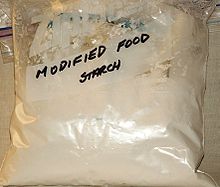This articleneeds additional citations forverification.(May 2010) |
Modified starch,also calledstarchderivatives,is prepared byphysically,enzymatically,orchemicallytreating nativestarchto change its properties.[1]Modified starches are used in practically all starch applications, such as in food products as athickening agent,stabilizeroremulsifier;inpharmaceuticalsas adisintegrant;or as binder incoated paper.They are also used in many other applications.[2]

Starches are modified to enhance their performance in different applications. Starches may be modified to increase their stability against excessive heat, acid, shear, time, cooling, or freezing, to change theirtexture,to decrease or increase theirviscosity,to lengthen or shortengelatinizationtime or to increase theirvisco-stability.
Modification methods
editAn ancient way of modifying starch ismaltinggrain, which humans have done for thousands of years. The plant's ownenzymesmodify the grain's starches. The effects can be modulated by varying the duration and the ambient conditions of the process. However, malting alone is not a limitless or optimized tool for every desirable end product. In recent centuries, humans have expanded their repertoire of starch-modifying methods by learning how to use simple substances such asacids,alkalis,andenzymesfrom nature to modify starches in tailored ways.
Acid-treated starch (INS1401),[3]also called thin boiling starch, is prepared by treatingstarchor starch granules withinorganic acids,e.g.hydrochloric acid(equivalent tostomach acid), breaking down the starch molecule and thus reducing the viscosity.
Other treatments producing modified starch (with differentINSandE-numbers) are:
- dextrin(INS 1400),[3]roasted starch withhydrochloric acid
- alkaline-modified starch (INS 1402)[3]withsodium hydroxideorpotassium hydroxide
- bleached starch (INS 1403)[3]withhydrogen peroxide
- oxidized starch (INS 1404, E1404)[3]withsodium hypochlorite,breaking down viscosity
- enzyme-treated starch (INS 1405),[3]maltodextrin,cyclodextrin
- monostarch phosphate(INS 1410, E1410) withphosphorous acidor the saltssodium phosphate,potassium phosphate,orsodium triphosphateto reduceretrogradation
- distarch phosphate(INS 1412, E1412) by esterification with for examplesodium trimetaphosphate,crosslinkedstarch modifying therheology,the texture
- acetylated starch(INS 1420, E1420)[3]esterificationwithacetic anhydride
- hydroxypropylated starch(INS 1440, E1440), starchether,withpropylene oxide,increasing viscosity stability
- hydroxyethyl starch,withethylene oxide
- starch sodium octenyl succinate (OSA) starch (INS 1450, E1450) used asemulsifieraddinghydrophobicity
- starch aluminium octenyl Succinate (INS 1452, E1452)
- cationic starch,adding positiveelectrical chargeto starch
- carboxymethylated starch withmonochloroacetic acidadding negative charge
and combined modifications such as
- phosphated distarch phosphate(INS 1413, E1413)
- acetylated distarch phosphate(INS 1414, E1414)
- acetylated distarch adipate(INS 1422, E1422),
- hydroxypropyl distarch phosphate(INS 1442, E1442),
- acetylated oxidized starch (INS 1451, E1451).[3]
Modified starch may also be a cold-water-soluble,pregelatinizedor instant starch which thickens and gels without heat, or a cook-up starch which must be cooked like regular starch. Drying methods to make starches cold-water-soluble areextrusion,drum drying,spray dryingordextrinization.
Other starch derivatives, the starch sugars, likeglucose,high fructose syrup,glucose syrups,maltodextrins,starch degraded withamylaseenzymeare mainly sold as liquidsyrupto make asweetener.
Examples of use and functionality of modified starch
editPre-gelatinized starch is used to thicken instantdesserts,allowing the food to thicken with the addition of cold water or milk.[4]Similarly,cheese saucegranules such as inMacaroni and Cheese,lasagna,orgravygranules may be thickened with boiling water without the product going lumpy. Commercialpizza toppingscontaining modified starch will thicken when heated in the oven, keeping them on top of the pizza, and then become runny when cooled.
A suitably modified starch is used as afat substitutefor low-fat versions of traditionally fatty foods, e.g.industrialmilk-based desserts likeyogurtor reduced-fat hardsalamihaving about 1/3 the usual fat content. For the latter type of uses, it is an alternative to the productOlestra.
Modified starch is added to frozen products to prevent them from dripping when defrosted. Modified starch, bonded withphosphate,allows the starch to absorb more water and keeps the ingredients together. Modified starch acts as an emulsifier forFrench dressingby enveloping oil droplets and suspending them in the water. Acid-treated starch forms the shell ofjelly beans.Oxidized starch increases the stickiness ofbatter.
Carboxymethylated starches are used as awallpaper adhesive,astextile printingthickener, astabletdisintegrantsandexcipientsin the pharmaceutical industry.
Cationicstarch is used as wet endsizingagent inpaper manufacturing.
Genetically modified starch
editModified starch should not be confused withgenetically modifiedstarch, which refers to starch fromgenetically engineered plants,such as those that have been genetically modified to produce novel fatty acids or carbohydrates which might not occur in the plant species being harvested. In Europe the term "Genetically Modified Organism"is used solely where" the genetic material has been altered in a way that does not occur naturally through fertilisation and/or natural recombination ".[5]The modification in "genetically modified" refers to the genetic engineering of the plantDNA,whereas in the term "Modified Starch" seen onmandatoryingredientlabelsit refers to the later processing or treatment of the starch or starch granules.
Genetically modified starch is of interest in the manufacture ofbiodegradable polymersand noncellulose feedstock in thepaper industry,as well as the creation of newfood additives.For example, researchers aim to alter the enzymes within living plants to create starches with desirable modified properties, and thus eliminate the need for enzymatic processing after starch is extracted from the plant.[6]
See also
edit- Acceptable daily intake– Measure of a substance in food or water
- Retrogradation (starch)– Gelatinization of starch
- Starch gelatinization– Process of breaking down the intermolecular bonds of starch by water
- Resistant starch– Dietary fiber
References
edit- ^Vickie Vaclavik; Vickie A. Vaclavik; Elizabeth W. Christian (2007).Essentials of food science(3rd ed.). Springer. p. 61.ISBN978-0-387-69939-4.
- ^Starch derivatization: fascinating and unique industrial opportunities, K. F. Gotlieb, A. Capelle, Wageningen Academic Publishers, 2005,ISBN978-90-76998-60-2
- ^abcdefgh"Codex General Standard for Food Additives (GSFA) Online Database"(PDF).
- ^Ma, Hao; Liu, Mei; Liang, Ying; Zheng, Xueling; Sun, Le; Dang, Wenqian; Li, Jie; Li, Limin; Liu, Chong (2022-06-01)."Research progress on properties of pre-gelatinized starch and its application in wheat flour products".Grain & Oil Science and Technology.5(2): 87–97.doi:10.1016/j.gaost.2022.01.001.ISSN2590-2598.
- ^"GMO".European food Standards Agency.24 April 2013.
- ^Zeeman, Samuel C.; Kossmann, Jens; Smith, Alison M. (2 June 2010)."Starch: Its Metabolism, Evolution, and Biotechnological Modification in Plants".Annual Review of Plant Biology.61(1): 209–234.doi:10.1146/annurev-arplant-042809-112301.PMID20192737.Retrieved16 July2021.
Suggested reading
edit- Ridgwell, Jenny (2001).GCSE food technology for OCR(2nd ed.). Oxford: Heinemann.ISBN978-0-435-41951-6.
- Revise for OCR GCSE Food Technology,Alison Winson. 2003.
- Degradable Polymers, Recycling, and Plastics Waste Management.S Huang,Ann-Christine Albertsson.1995.
- Modified Starch,Jenny Ridgwell, Ridgwell Press, 2001,ISBN978-1-901151-07-7